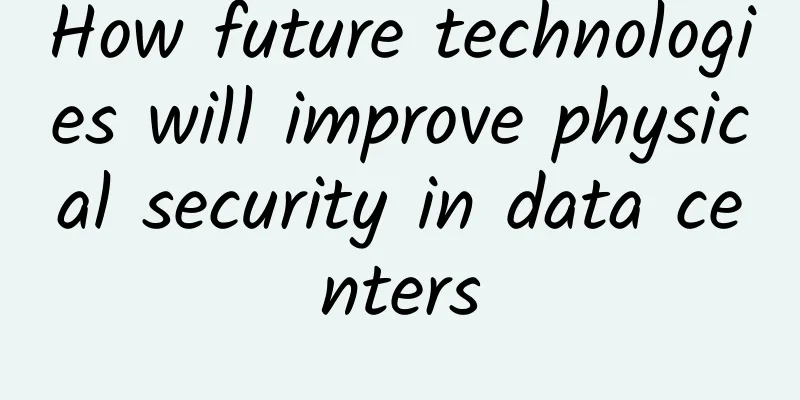How future technologies will improve physical security in data centers

|
In recent years, the demand for security solutions in the data center market has increased dramatically. As the market continues to grow rapidly, it brings more opportunities and challenges to suppliers and operators.
The data center industry will face two major challenges: The first is compliance. Regulatory compliance is increasing, and data center operators need to do more work, not only to comply with regulations, but also to provide a safe and secure environment for data center assets. The second is human error. Data center staff and operators will inevitably make mistakes that may inadvertently affect the operation of the data center. Data loss or downtime can result in huge costs for the enterprise. Data center managers can help mitigate these risks by controlling and optimizing who, where and when around rack equipment – who has access, where, when and for how long. This is increasingly common, especially in co-located data centers, where the opportunity for human error and malicious sabotage increases with the number of people in the data center. So, what are the main factors that data center managers need to consider when investing in a physical security solution? Many data centers will have some form of physical security embedded in them, but managers need to consider the ease of implementation and the value to customers when upgrading. The ease of retrofitting current solutions is key, and depending on whether data center managers choose a wired or wireless solution, they need to consider how the project will affect the short-term day-to-day operations of their facility. This is an area where data center operators are focusing their efforts and continue to work closely with data center rack providers to provide comprehensive retrofit solutions that are easy to implement and minimize disruption to the data center. They are often suitable for existing equipment and do not require additional cutting or drilling. As the need for enhanced physical security continues to grow, upgrades need to be considered in a way that minimizes the impact on data center operations. Working with a partner who has extensive experience in implementing these projects will help ensure that upgrades can be conducted safely and securely. With advances in biometrics and other emerging technologies, how can one expect access technology to evolve over the next five years? Today, IoT devices generate exponentially more and more data, whether it is for the security and financial industries or for research, many of the target customers and applications will work in those sensitive areas. As data becomes more important and more sensitive, it must be protected, requiring at least some level of audit trail and accountability. As data centers become more complex, improved security layers and tracking capabilities are needed at every level. We are seeing more demand for integrating keys and access control into the user's phone, providing the user with a protected key that can only be accessed through authorization by data center managers to predefined racks for a predefined length of time. And that's just one way we are seeing customer demand shift. Another way is through identification via biometrics, such as facial recognition, fingerprint scanning and iris recognition, as these technologies become more accessible and, more importantly, secure, it is expected that the demand to incorporate these security measures into existing solutions will inevitably grow. This brings more complexity to an already complex data center environment and requires the introduction of many pre-authorization checks to allow basic access. These security measures may affect the speed of data center operations, but can promote the continued development of the data center market in the next few years. |
<<: The difference between SDN and traditional network operation and maintenance
>>: NFV is stumbling forward and entering the second half
Recommend
Will the countdown to 3G shutdown trigger a wave of phone replacement across all networks?
On May 5, China Telecom recently issued an announ...
80VPS: Cluster server starting from 900 yuan/month, 8C segment US/Hong Kong multiple data centers, optional CN2 line
80VPS is a long-established Chinese hosting compa...
Liuliu Cloud: US 9929/UK/Japan native IP hosting monthly payment starting from 50 yuan
666clouds is a Chinese hosting company founded in...
Connecting the industrial ecosystem, 5G accelerates the empowerment of thousands of industries
As the saying goes, a single tree cannot make a f...
Spring is coming, the cancellation of data roaming charges? Beware of scams
Mr. Dongguo and the wolf, Lu Dongbin and the dog,...
Interviewer: What are the common HTTP request headers?
[[401820]] This article is reprinted from the WeC...
Breaking news: China Unicom announced that it will shut down its 2G network. After 17 years, 2G has successfully retired!
Not long ago, there was news that China Unicom wa...
Bacloud: 15% off KVM VPS, 25% off dedicated servers, 10TB hard drive server starting at $28.96/month
Bacloud is a Lithuanian hosting company founded i...
“Number Portability” is officially launched nationwide today! Who will be the next “pain point” to be solved?
Yesterday, the national "number portability&...
Who moved my Activity?
[[312428]] Preface I wonder if you have ever thou...
Delisted from the New York Stock Exchange! The three major operators gave a "cold" treatment, and the Ministry of Commerce and the China Securities Regulatory Commission responded with a "response"
Affected by the New York Stock Exchange's dec...
Huawei releases four new smart security products to usher in a new era of AI and win-win intelligence
[51CTO.com original article] Recently, Huawei'...
Wi-Fi 6 is not yet popular, so why has the latecomer Wi-Fi 7 become a battlefield for giants?
When it comes to Wi-Fi, everyone is familiar with...
The difference between continuous delivery and continuous deployment
Continuous delivery does not mean that every chan...









